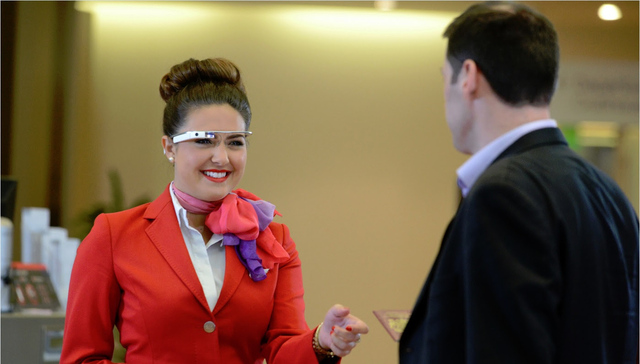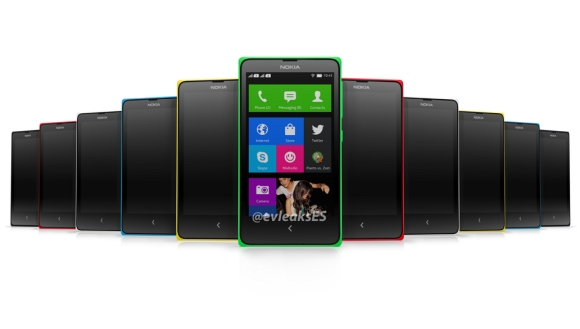
Virgin Atlantic has begun a six-week test aimed at giving its employees more information about some passengers as they enter the London Heathrow airport. The program, which is currently designed only to aid customer service staff attending to upper class passengers, uses Google Glass and Sony's SmartWatch 2 to serve up information about passengers and their destinations:
From the minute Upper Class passengers step out of their chauffeured limousine at Heathrow's T3 and are greeted by name, Virgin Atlantic staff wearing the technology will start the check-in process. At the same time, staff will be able to update passengers on their latest flight information, weather and local events at their destination and translate any foreign language information. In future, the technology could also tell Virgin Atlantic staff their passengers' dietary and refreshment preferences - anything that provides a better and more personalized service.
FOR FLIGHT INFO, WEATHER, AND LOCAL EVENTS
Virgin says the program replaces an existing service that gave its employees customized information. If successful, Virgin says it could bring Glass or the Sony watches to other airports, though the company did not say whether it might trickle the service down to passengers with lower tier tickets.
Google Glass continues to be available only to those who sign for up the company's Glass Explorer program, with the hardware running $1,499 a pair (or more if you opt for the new prescription frames). It's unclear just how many units of Glass and the Sony smartwatch Virgin Atlantic bought and plan to use as part of the pilot.

On Sunday, we told you about a new BlackBerry handset found on the Geekbench benchmark site. Rumored to be a high-end model called the BlackBerry "Ontario," this is certainly not one of the entry-level handsets for developing markets being produced by Foxconn for BlackBerry. The "Ontario" features a quad-core Snapdragon 800 MSM8974 under the hood, underclocked at 2.15GHz.
The BlackBerry "Ontario" will be part of the BlackBerry "O" series. The same quad-core Snapdragon 800 MSM8974 to be used in the "Ontario" will also find its way into the BlackBerry "W" series (featuring a physical QWERTY) and the BlackBerry "B" (all-touch) handsets.
If a quad-core 'Berry doesn't convince you that the Canadian manufacturer is still in it to win it, consider the latest rumor. According to multiple sources, BlackBerry plans on employing the MSM8994 SoC on a new high-end device in 2015. This chip, built using the 20nm process, includes a 64 bit octa-core 2.5GHz CPU, 4GB of RAM, an Adreno 430 GPU, and an integrated 4G LTE modem.
Combined with the right specs, it sounds like BlackBerry could have a monster on its hands next year. CEO John Chen just needs to make it through this year first.
source: N4BB, CNET

The soak test is apparently over for users with the unlocked (aka T-Mobile) model of the Motorola Moto X. Users are starting to see the Android 4.4.2 update rolling out to the device; and, the update does bring a some new functionality as well as a couple bug fixes that were not part of the change log for Android 4.4.2 when we saw it hit the Nexus devices.
Although this is technically just a bug fix update, it is quite sizable at 146.7MB, which extra odd because the size of the bugs being squashed doesn't seem all that big. First on the change log is the addition of Google's Cloud Print functionality which will allow you to print documents from various apps via Wi-Fi or Bluetooth to either a Cloud Print enabled printer or to a FedEx store.
On the bug fix side of the update, there were apparently bugs that were causing battery life issues for users on Android 4.4 as well as possible issues with syncing a Microsoft Exchange account. Both of those bugs have been fixed, according to Motorola.
Unfortunately, that means it doesn't look like there are any more camera fixes in the update (although it seems to us that the camera is faster to launch when using the quick gesture). We were hoping that Motorola would have also found a way to have similar camera fixes to those seem on the Nexus 5, because the Moto X camera is a bit slow to focus, which does also cause white balance issues.
img source: Android Police
According to The Wall Street Journal, Nokia will release its first Android smartphone this month. Known as Nokia Normandy, the low-cost handset will reportedly be showcased during MWC in Barcelona.

According to WSJ’s sources, Nokia was hard at work on the device while Microsoft was performing due diligence prior to its acquisition of the Finnish company. The smartphone will allegedly go official as Nokia X.
Unsurprisingly, the smartphone is tipped to launch without Google Play support, similarly to Amazon’s Kindle products. Instead, it will be focused on services provided by Microsoft and Nokia. In line withrecent leaks, the UI of the upcoming smartphone is also said to be closely related to Microsoft’s Windows Phone 8.
Rumored specs of the Nokia X include dual-core Snapdragon 200 SoC, dual-SIM, 4” WVGA display, 4GB of built-in memory, and 512MB of RAM. The handset will reportedly be priced in line with Nokia Asha devices.
All things considered, The Wall Street Journal report reaffirms the already floating batch of rumors. We are quite curious to find out how the device’s launch will affect the sales of Nokia’s popular low-end Windows Phone devices such as the Lumia 520 and 525. Nokia Lumia 520 in particular is responsible for 30% of all Windows Phone sales.
Source (registration required)

 JC Torres
JC Torres
It may not be the most popular tablet around, but the Surface 2 might soon be a fixture in airplanes and pilots' equipment. The FAA has just authorized Microsoft's oft belittled tablet for pilot use in all phases of flights.
This is subtly different from the other FAA action that approved the use of electronic devices in all phases of flights. While that allowed passengers to use their tablets and gadgets, this latest authorization allows pilots to add the Surface 2 as part of their Electronic Flight Bags or EFBs, particularly in Class 1 and Class 2 EFBs, which usually include commercial off the shelf devices like laptops or handhelds.
Of course, this approval doesn't mean that airlines will start offering Surface 2 tablets as the de facto gadget for their pilots. FAA authorization only means that when and if an airline asks for approval to get the Surface 2 in their list, the process will go much faster since Microsoft has already passed the FAA's standards. Whether airlines actually start adopting the tablets into their system is a different question entirely.
Microsoft might be in need of such new customers for its latest generation of tablets. The Surface 2, which is the successor of the Surface RT, has not exactly been the wild success that Microsoft has always hoped it would be. While the Surface 2 does indeed represent animprovement over its predecessor, it still exhibits one of the major criticisms of that device line.
In the end, it all boils down to software. While it has a slightly different name, it shares the same software lineage of Windows RT, the ARM-based OS that Microsoft has put out. Users, and by that we mean pilots, will have very few choices when it comes to apps they can use, which may be a factor in favor of management. That said, if Microsoft is keeping a very close eye on this new target market, then it might take a more active role in making sure that certain apps, especially those related to the industry, will become available and compatible with the Surface 2.
VIA: BetaNews




